height Citroen GRAND C4 PICASSO RHD 2016 2.G Owner's Manual
[x] Cancel search | Manufacturer: CITROEN, Model Year: 2016, Model line: GRAND C4 PICASSO RHD, Model: Citroen GRAND C4 PICASSO RHD 2016 2.GPages: 523, PDF Size: 13.63 MB
Page 5 of 523
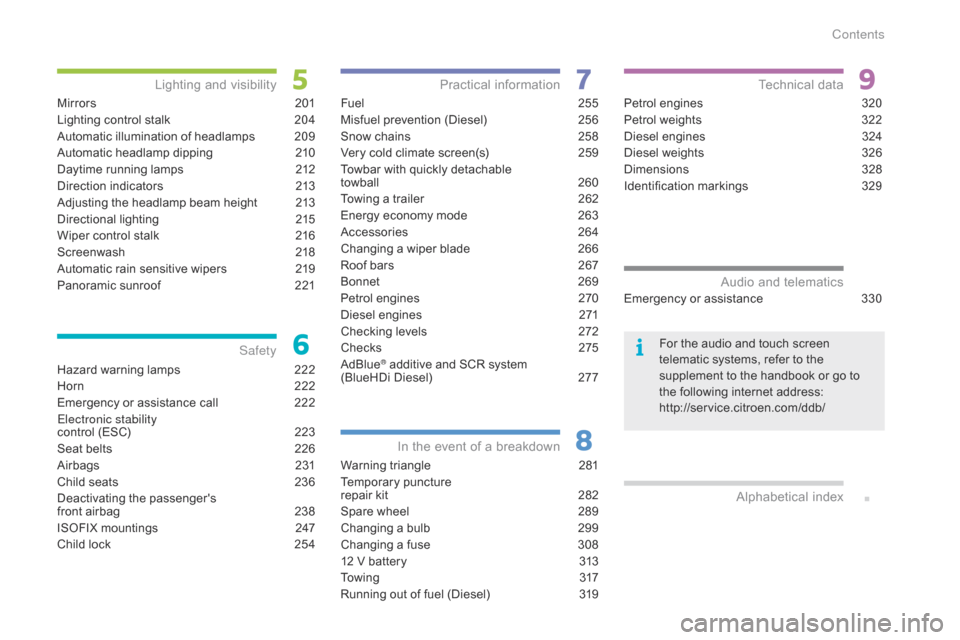
Hazard warning lamps 222
Horn
2
22
Emergency
or assistance call
2
22
Electronic stability
control
(ESC)
2
23
Seat
bel
ts
2
26
Airbags
2
31
Child
seats
2
36
Deactivating
t
he
p
assenger's
f
ront airbag
2
38
ISOFIX
mountings
2
47
Child
lock
2
54
Safety
Fuel 2 55
Misfuel prevention (Diesel)
2
56
Snow
chains
2
58
Very
cold climate screen(s)
2
59
Towbar
with quickly detachable
towball
2
60
Towing
a trailer
2
62
Energy
economy mode
2
63
Accessories
2
64
Changing
a wiper blade
2
66
Roof
bars
2
67
Bonnet
26
9
Petrol
engines
2
70
Diesel
engines
2
71
Checking
levels
2
72
Checks
2
75
AdBlue
® additive and SCR system
(
BlueHDi Diesel) 2 77
Practical information
Warning triangle 2 81
Temporary
pu
ncture
r
epair kit
2
82
Spare
wheel
2
89
Changing
a bulb
2
99
Changing
a fuse
3
08
12
V battery
3
13
To w i n g
3
17
Running
out of fuel (Diesel)
3
19
In the event o f a b reakdown
Petrol engines 3 20
Petrol weights
3
22
Diesel
engines
3
24
Diesel
weights
3
26
Dimensions
3
28
Identification
ma
rkings
3
29
Technical data
Emergency or assistance 3 30Audio and telematics
Mirrors 2 01
Lighting control stalk
2
04
Automatic
illumination of headlamps
2
09
Automatic
headlamp dipping
2
10
Daytime
running lamps
2
12
Direction
indicators
2
13
Adjusting
the headlamp beam height
2
13
Directional
l
ighting
2
15
Wiper
control stalk
2
16
Screenwash
2
18
Automatic
rain sensitive wipers
2
19
Panoramic
sunroof
2
21
Lighting and v isibility
Alphabetical
in
dex
For the audio and touch screen telematic systems, refer to the
s
upplement to the handbook or go to
t
he following internet address:
http://service.citroen.com/ddb/
Contents
Page 6 of 523

4
Exterior
Fuel tank, misfuel
p revention 25 5-257
Wipers,
screenwash
2
16 -220
Changing a wiper blade
2
66
Exterior welcome lighting
2
12-213
Door mirror spotlamps
2
12
Cornering lighting
2
14
Directional
l
ighting
2
15
Adjusting the headlamp beam height 213
Changing bu
lbs 2
99-303
-
f
ront
lamps
-
fo
glamps
-
d
irection
indicator
repeaters
Very
cold
climate
screen(s)
2
59
Door
mirrors
2
01-202
Panoramic
sunroof
2
21
Roof
bars
2
67
Accessories
26
4-265
ESC:
ABS,
EBA,
ASR,
DSC
2
23 -225
Tyre
under-inflation
detection
1
98 -200
Tyre
pressures
3
29
Temporary
puncture
repair
kit
2
82-288
Changing
a
wheel
2
89 -298
-
t
ools
-
s
pare
wheel
-
r
emoving
/
refitting
Snow
chains
2
58
Changing
bu
lbs
3
03-307
-
r
ear
lamps
-
3
rd
brake
lamp
-
n
umber
plate
lamps
-
fo
glamps
Parking
sensors
1
85 -186
Reversing
camera
1
87
360
Vision
1
88 -189
Park
Assist
1
90 -197
Towbar
1
22,
262
Towing
(advice)
3
17-318
Towbar
with
quickly
detachable
tow
ball
2
60-261
Boot
6
3-69
-
o
pening
/
closing
- em
ergency r
elease
Motorised
tailgate
6
4- 67
Hands-free
tailgate
6
8 - 69
Electronic
key
/
"Keyless
Entry
and
S
tarting"
system
5
1-59
-
o
pening
/
closing
-
a
nti-theft
protection
-
b
ack-up
control
-
b
attery
Doors
61
- 62
-
o
pening
/
closing
-
em
ergency
c
ontrol
Central
locking
6
0
Alarm
7
0-72
Electric
windows
7
3 -74
Over view
Page 9 of 523

7
Hazard warning lamps 222
Adjusting the headlamp
beam
height
2
13
Steering
wheel adjustment
9
1
Horn
2
22
START/STOP
button
1
23 -128 Wiper
and screenwash
controls
2
16-220
Trip computer
4
8 -50
Lighting controls
2
04-213
Direction indicators
2
13
Instruments and controls (cont.)
Memorising speeds 1
47
Speed limit recognition 1 48 -151
Speed
limiter
1
52-154
Cruise
control
1
55 -157
Dynamic
cruise control
1
58 -164
Dynamic
cruise control with
S
top function
1
65 -173
Inter-vehicle
distance
1
66, 169
Black
panel
4
7
Modes
19
-20
.
Over view
Page 68 of 523
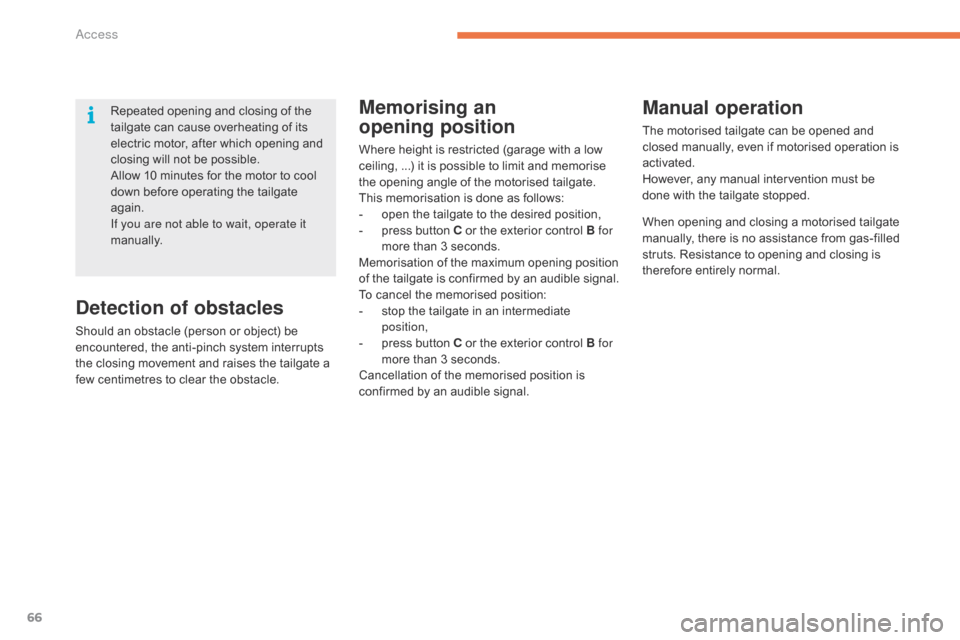
66
Memorising an
opening position
Where height is restricted (garage with a low c
eiling, ...) it is possible to limit and memorise
t
he opening angle of the motorised tailgate.
This
memorisation is done as follows:
-
o
pen the tailgate to the desired position,
-
p
ress button C or the exterior control B for
more
than 3 seconds.
Memorisation
of the maximum opening position
o
f the tailgate is confirmed by an audible signal.
To
cancel the memorised position:
-
s
top the tailgate in an intermediate
p
osition,
-
p
ress button C or the exterior control B for
more
than 3 seconds.
Cancellation
of the memorised position is
c
onfirmed by an audible signal.
Manual operation
The motorised tailgate can be opened and closed manually, even if motorised operation is
a
ctivated.
However,
any manual intervention must be
d
one with the tailgate stopped.
Repeated
opening
and
closing
of
the
t
ailgate
can
cause
overheating
of
its
e
lectric
motor,
after
which
opening
and
c
losing
will
not
be
possible.
Allow
10
minutes
for
the
motor
to
cool
d
own
before
operating
the
tailgate
ag
ain.
If you are not able to wait, operate it
manually.
Detection of obstacles
Should an obstacle (person or object) be e ncountered, the anti-pinch system interrupts
t
he closing movement and raises the tailgate a
f
ew centimetres to clear the obstacle. When
opening and closing a motorised tailgate
m
anually, there is no assistance from gas-filled
s
truts. Resistance to opening and closing is
t
herefore entirely normal.
Access
Page 77 of 523
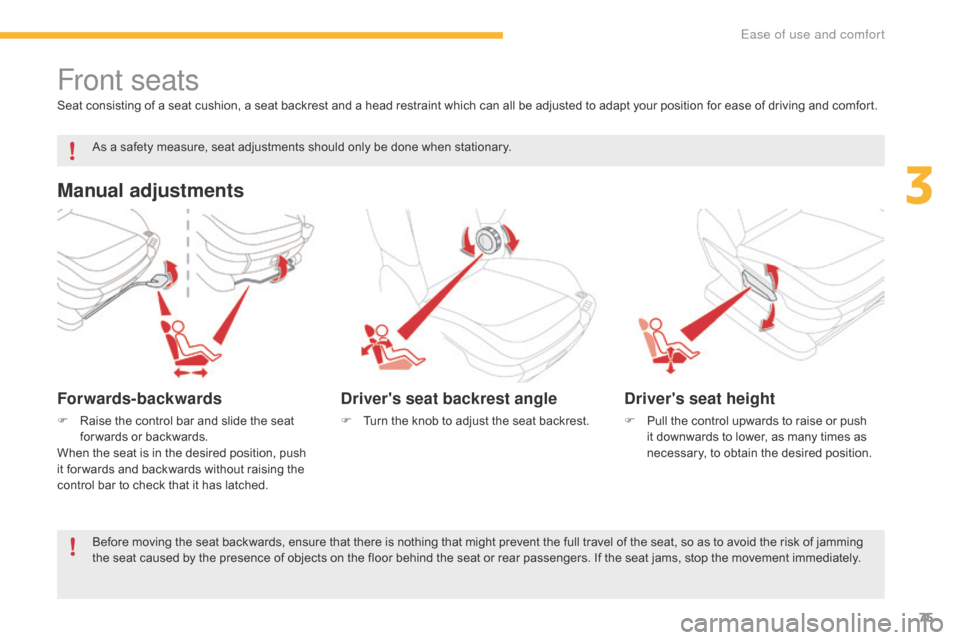
75
Front seats
Manual adjustments
Forwards-backwards
F Raise the control bar and slide the seat f
or wards or backwards.
When
the seat is in the desired position, push
i
t for wards and backwards without raising the
c
ontrol bar to check that it has latched.
Driver's seat backrest angle
F Turn the knob to adjust the seat backrest.
As
a
safety
measure,
seat
adjustments
should only be done when stationary.
Driver's seat height
F Pull
the control upwards to raise or push i
t downwards to lower, as many times as
n
ecessary, to obtain the desired position.
Seat
consisting
of
a
seat
cushion,
a
seat
backrest
and
a
head
restraint
which
can
all
be
adjusted
to
adapt your position for ease of driving and comfort.
Before
moving
the
seat
backwards,
ensure
that
there
is
nothing
that
might
prevent
the
full
travel
of the seat, so as to avoid the risk of jamming
t
he
seat
caused
by
the
presence
of
objects
on
the
floor
behind
the
seat
or
rear
passengers.
If
the
seat jams, stop the movement immediately.
3
Ease of use and comfort
Page 79 of 523
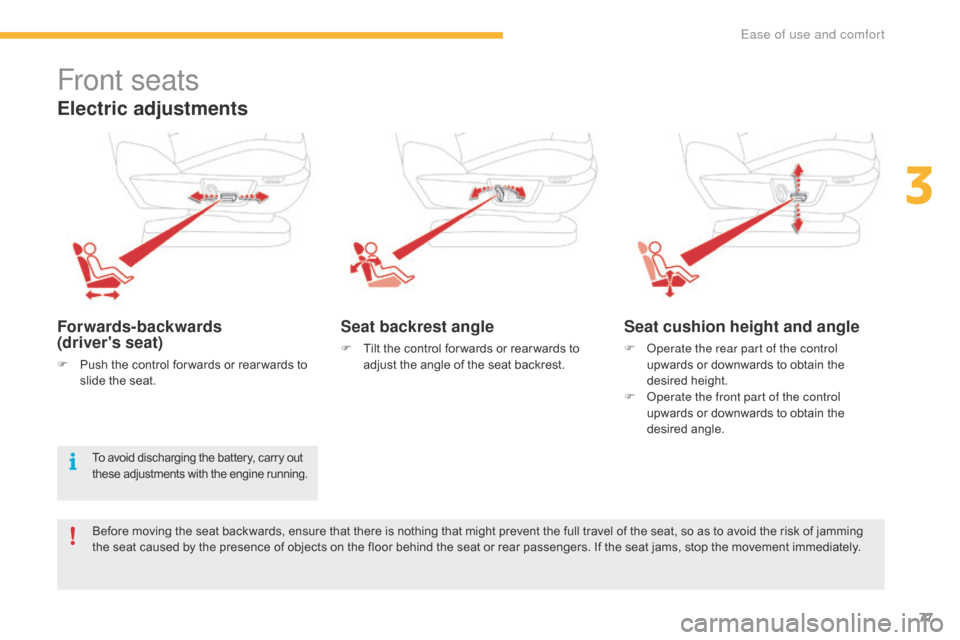
77
Front seats
Electric adjustments
Forwards-backwards
(driver's seat)
F Push the control for wards or rear wards to s
lide the seat.
Seat backrest angle
F Tilt the control for wards or rear wards to a
djust the angle of the seat backrest.
Seat cushion height and angle
F Operate the rear part of the control upwards or downwards to obtain the
de
sired
h
eight.
F
O
perate the front part of the control
upwards
or downwards to obtain the
de
sired
a
ngle.
To avoid discharging the battery, carry out these adjustments with the engine running.
Before moving the seat backwards, ensure that there is nothing that might prevent the full travel of the seat, so as to avoid the risk of jamming the seat caused by the presence of objects on the floor behind the seat or rear passengers. If the seat jams, stop the movement immediately.
3
Ease of use and comfort
Page 81 of 523

79
Additional adjustments
Head restraint height and angle
(depending on version)
The head restraint is fitted with a frame with notches which prevents it from lowering; this is
a
safety device in case of impact.
The adjustment is correct when the upper
edge of the head restraint is level with the
top of the head. Never
drive with the head restraints
r
emoved; they must be in place and
adj
usted
c
orrectly.
F
T
o raise a head restraint, pull it upwards.
F
To lower the head restraint, press the lug A and the p
ush the head restraint down at the same time.
F To adjust the angle of the head restraint, tilt i
ts lower part for wards or backwards.
Removing a head restraint
F To remove the head restraint, press the l
ug A and pull the head restraint upwards.
F
To put the head restraint back in place, engage the head restraint stems in the openings
k
eeping them in line with the seat backrest and
p
ress the lug A at the same time.
Relax head restraints
Depending on version, you can fold the sides to obtain a more comfortable position.F
P
ress the control to obtain the desired
l
umbar
sup
port.
Electric lumbar adjustment
3
Ease of use and comfort
Page 83 of 523

81
Heated seats control
F Use the adjustment wheel to switch on and s
elect the level of heating required:
0 :
Off.
1 :
Low.
2 :
Medium.
3 :
High.
With
the engine running, the front seats can be
h
eated
s
eparately.
Before
operating
the
leg
rest,
ensure
t
hat
nothing
could
inter fere
with
its
m
ovement.Electric passenger seat
F Push the control for wards or backwards to u
nfold or fold away the leg rest.
The
movement stops when you release the
c
ontrol.
Front armrest
Height adjustment
F Fully lower the armrest.
F R aise it to the required position (low,
i
ntermediate or high).
F
O
nce in the high position, lift to release it
a
nd return it to the low position.
Comfort
system for the driver and front
p
assenger.
3
Ease of use and comfort
Page 93 of 523
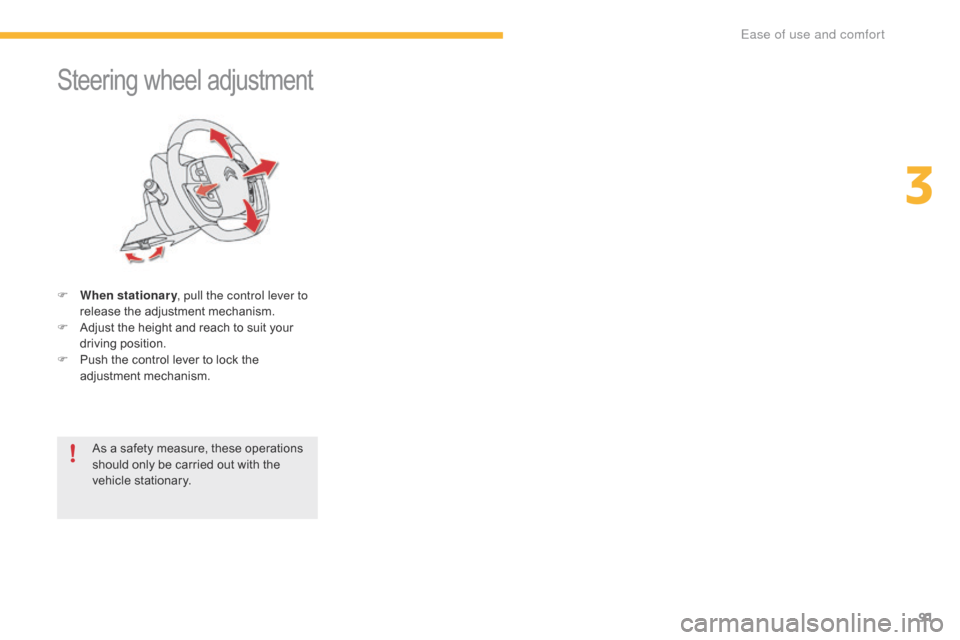
91
Steering wheel adjustment
F When stationary , pull the control lever to
release the adjustment mechanism.
F
A
djust the height and reach to suit your
d
riving position.
F
P
ush the control lever to lock the
a
djustment
m
echanism.
As
a safety measure, these operations
s
hould only be carried out with the
v
ehicle stationary.
3
Ease of use and comfort
Page 124 of 523
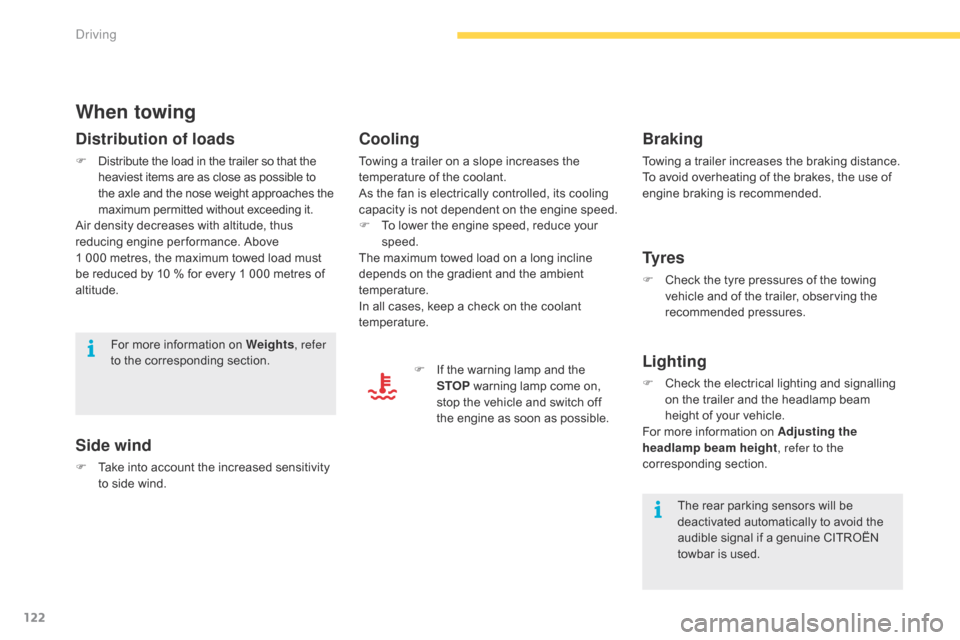
122
When towing
Distribution of loads
F Distribute the load in the trailer so that the h
eaviest items are as close as possible to t
he axle and the nose weight approaches the
m
aximum permitted without exceeding it.
Air
density decreases with altitude, thus
r
educing engine per formance. Above
1 0
00 metres, the maximum towed load must
b
e reduced by 10 % for every 1 000 metres of
al
titude.
Side wind
F Take into account the increased sensitivity t
o side wind.
For
more information on Weights
, refer
to the corresponding section.
The rear parking sensors will be
d
eactivated automatically to avoid the
a
udible signal if a genuine CITROËN
t
owbar is used.
Cooling
Towing a trailer on a slope increases the temperature of the coolant.
As
the fan is electrically controlled, its cooling
c
apacity is not dependent on the engine speed.
F
T
o lower the engine speed, reduce your
s
peed.
The
maximum towed load on a long incline
d
epends on the gradient and the ambient
t
emperature.
In
all cases, keep a check on the coolant
t
emperature. F
I
f the warning lamp and the
S
TOP
warning lamp come on,
s
top the vehicle and switch off
t
he engine as soon as possible.
Braking
Towing a trailer increases the braking distance.
T o avoid overheating of the brakes, the use of
e
ngine braking is recommended.
Ty r e s
F Check the tyre pressures of the towing v
ehicle and of the trailer, observing the
re
commended
p
ressures.
Lighting
F Check the electrical lighting and signalling o
n the trailer and the headlamp beam
h
eight of your vehicle.
For
more information on Adjusting the
headlamp beam height , refer to the
corresponding
s
ection.
Driving